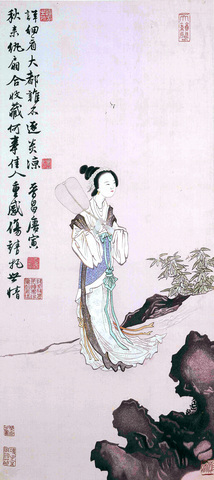Julia Wu (
Chinese embroidery owes a big part of its existence to the confinement of women to the home. From the age of six, young girls were taught by their mothers to stitch and together they would embroider garments and tapestries to be used as dowry payments. After marriage, the mother-in-law would determine the character of her son's bride by the quality of her stitching.
"Generations of women would come together to work. They couldn't leave the house so they would sit for hours every day. A lot of thought went into their work. It provided a way for them to express their desires and thoughts at the time," Wu said.

PHOTOS COURTESY OF ULIA WU
Given the difficulty of preserving embroidery work, Wu said it is rare to find pieces from prior to the Qing Dynasty, and the invention of electric machinery led to the end of this handicraft, which is now a rare practice except in some rural areas of China. Even that which is done by hand now does not compare to the work produced by women in the mid to late Qing Dynasty, she said, citing the use of chemical dyes as one reason.
The layout of the exhibition is simple and minimal. Most of the 30 works are hung around the small gallery with a few pieces enclosed in display cabinets. Beside each work is a small plaque with a brief description of how, when and where the work was used. From the entrance, on the right side are pieces representing Beijing-style embroidery and on the left are works from China's southern regions. Both styles vary in their patterns' decoration and type of stitching.
The works include mostly decorative hangings along with a few garments that Wu purchased from antique boutiques in China. One of the more interesting pieces on display is the pair of shoes worn by women whose feet were bound at birth. It's the infant size of the shoes rather then the embroidery that make them so fascinating to look at.

As with traditional Chinese painting, a deep understanding of the motifs is imbedded in each of these embroidered works. There are pieces decorated with familiar symbols of peonies, Mandarin ducks and dragons.
What is obvious is the extremely precise labor that goes into each piece. From the detail in human expression to the seal signatures, the precision of the stitching makes it difficult to differentiate these embroidered works from ink paintings.
Event notes :

What: The exhibition of Chinese embroidery from the Qing Dynasty
Where: The basement gallery of Sun Yat-sen Memorial Hall, 505 Renai Rd, Sec 4, Taipei (
When: Daily 9am to 5pm until Sunday

One of the biggest sore spots in Taiwan’s historical friendship with the US came in 1979 when US president Jimmy Carter broke off formal diplomatic relations with Taiwan’s Republic of China (ROC) government so that the US could establish relations with the People’s Republic of China (PRC). Taiwan’s derecognition came purely at China’s insistence, and the US took the deal. Retired American diplomat John Tkacik, who for almost decade surrounding that schism, from 1974 to 1982, worked in embassies in Taipei and Beijing and at the Taiwan Desk in Washington DC, recently argued in the Taipei Times that “President Carter’s derecognition

This year will go down in the history books. Taiwan faces enormous turmoil and uncertainty in the coming months. Which political parties are in a good position to handle big changes? All of the main parties are beset with challenges. Taking stock, this column examined the Taiwan People’s Party (TPP) (“Huang Kuo-chang’s choking the life out of the TPP,” May 28, page 12), the Democratic Progressive Party (DPP) (“Challenges amid choppy waters for the DPP,” June 14, page 12) and the Chinese Nationalist Party (KMT) (“KMT struggles to seize opportunities as ‘interesting times’ loom,” June 20, page 11). Times like these can

Dr. Y. Tony Yang, Associate Dean of Health Policy and Population Science at George Washington University, argued last week in a piece for the Taipei Times about former president Ma Ying-jeou (馬英九) leading a student delegation to the People’s Republic of China (PRC) that, “The real question is not whether Ma’s visit helps or hurts Taiwan — it is why Taiwan lacks a sophisticated, multi-track approach to one of the most complex geopolitical relationships in the world” (“Ma’s Visit, DPP’s Blind Spot,” June 18, page 8). Yang contends that the Democratic Progressive Party (DPP) has a blind spot: “By treating any

You can tell a lot about a generation from the contents of their cool box: nowadays the barbecue ice bucket is likely to be filled with hard seltzers, non-alcoholic beers and fluorescent BuzzBallz — a particular favorite among Gen Z. Two decades ago, it was WKD, Bacardi Breezers and the odd Smirnoff Ice bobbing in a puddle of melted ice. And while nostalgia may have brought back some alcopops, the new wave of ready-to-drink (RTD) options look and taste noticeably different. It is not just the drinks that have changed, but drinking habits too, driven in part by more health-conscious consumers and